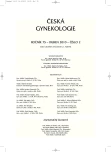Survey of contraceptive behaviour and attitude of Czech women towards different types of contraception
Authors:
P. Gregorová 1,2; P. Weiss 1; V. Unzeitig 3; D. Cibula 4
Authors‘ workplace:
Sexuologický ústav 1. LF UK a VFN, Praha, přednosta doc. MUDr. J. Zvěřina, CSc.
1; GONA, soukromé sexuologické centrum, Praha, ředitel MUDr. L. Horčička
2; Gynekologicko-porodnická klinika LF MU, Brno, přednosta prof. MUDr. P. Ventruba, DrSc.
3; Gynekologicko-porodnická klinika 1. LF UK a VFN, Praha, přednosta prof. MUDr. A. Martan, DrSc.
4
Published in:
Ceska Gynekol 2010; 75(2): 141-148
Overview
Objective:
Survey of contraceptive behaviour and attitude of Czech women towards different types of contraception.
Design:
Representative survey.
Methods:
Anonymous questionnaire survey of the sample of 1011 Czech women aged from 15 to 50.
Results:
More than half of the women of our sample used some form of contraception during their first sexual intercourse. Most of the women used condom (41 %), only a small part used hormonal contraception or withdrawal. Eighty percent of Czech women use some form of contraception with their stable partner, most often hormonal contraception (51 %). One sixth of Czech women use condom. Using contraception is influenced mostly by age and religious belief: younger respondents show more responsible contraceptive behaviour at their first sexual intercourse, they use hormonal contraception with their stable partner more often. Furthermore, atheists protect themselves by some form of contraception more often than believers. The most used form is hormonal contraception.
Conclusion:
Czech women show responsible contraceptive behaviour during their heterosexual intercourse. There is a significant increase of using hormonal contraception.
Key words:
contraception, attitude, use.
Sources
1. Abma, JC., Sonenstein, FL. Sexual activity and contraceptive practices among teenagers in the United States, 1988 and 1995. Vital Health Stat, 2001, 23, p. 1-79.
2. Dei, M., Bruni, V., Bettini, P., et al. The resistance to contraceptive use in young Italian women. Eur J Contracept Reprod Health Care, 2004, 9, p. 214-220.
3. Du, Y., Melchert, H., Schäfer-Korting, M. Use of oral contraceptives in Germany: prevalence, determinants and use-associated health correlates. Results of National Health Surveys from 1984 to 1999. Eur J Obstet Gynecol Reprod Biol, 2007, 134, p. 57-66.
4. Čepický, P., Líbalová, Z. Postoje žen ke kombinované orální kontracepci (COC). Mod Gynek Porod, 2003, 12, suppl. B, s. 190-208.
5. Ergocmen, BA., Koc, I., Senlet, P., et al. A closer look at traditional contraceptive use in Turkey. Eur J Contracept Reprod Health Care, 2004, 9, 221-244.
6. Glei, DA. Measuring contraceptive use patterns among teenage and adult women. Fam Plann Perspect, 1999, 31, p. 73-80.
7. Hacker, KA., Amare, Y., Strunk, N., Horst, L. Listening to youth: teen perspectives on pregnancy prevention. J Adolesc Health, 2000, 26, p. 279-288.
8. Ince, N., Ozyildirim, BA., Ozden, YI. The use of family planning methods in an administrative district of Istanbul. Eur J Contracept Reprod Health Care, 2003, 8, p. 21-26.
9. LaveissiŹre, MN., Pelissier, C., Le, MG. La contraception orale en France en 2001: résultats d’une enquźte par sondage portant sur 3609 femmes Čgées de 15 ą 45 ans. Gynécologie obstétrique et fertilité, 2003, 31, p. 220-229.
10. Robin, G., Letombe, B. Non hormonal contraception. Rev Pract, 2008, 58, p. 29-40.
11. Spinelli, A., Talamanca, IF., Lauria, L. Patterns of contraceptive use in 5 European countries. European Study Group on Infertility and Subfecundity. Am J Public Health, 2000, 90, p. 1403-1408.
12. Taylor, T., Keyse, L., Bryant, A. Contraception and sexual health 2005/06. A report on research using the ONS Omnibus Survey produced by the Office for National Statistics on behalf or the Department of Helath, London. Office for National Statistics, 2006.
13. United nations. Department of Economic and Social Affairs: World contraceptive use 2007. http://www.unpopulation.org. Accessed 11.5.2008.
14. Uzel, R., Ketting, E., Visser, A., Lehert, P. Hormonální antikoncepce. Postoje a praxe českých a slovenských žen. Mod Gynek Porod, 1993, 3, p. 42-53.
15. Vroom, F., de Jong, PH., van den Berg, PB., et al. Use of oral contraceptives in the years 1994-2002: Different but not less. Ned Tijdschr Geneeskd, 2005, 149, p. 23-28.
16. Weiss, P., Zvěřina, J. Kontracepční chování obyvatel České republiky: výsledky národního výzkumu. Čes Gynek, 1997, 62, s. 151-157.
17. Woynarowska, B., Izdebski, Z., Kololo, H., Mazur, J. Sexual initiation and use of condoms and other methods of contraception among 15-year-old adolescents in Poland and other countries. Ginekol Pol, 2004, 75, s. 621-632.
Labels
Paediatric gynaecology Gynaecology and obstetrics Reproduction medicineArticle was published in
Czech Gynaecology

2010 Issue 2
Most read in this issue
- Current possibilities for diagnosis of vulvovaginal infection
- Significance of hysteroscopic resection in diagnostics of endometrial cancer
- Recommendation for hormone replacement therapy in postmenopause
- New Single-Incision Sling System MiniArc in treatment of the female stress urinary incontinence
